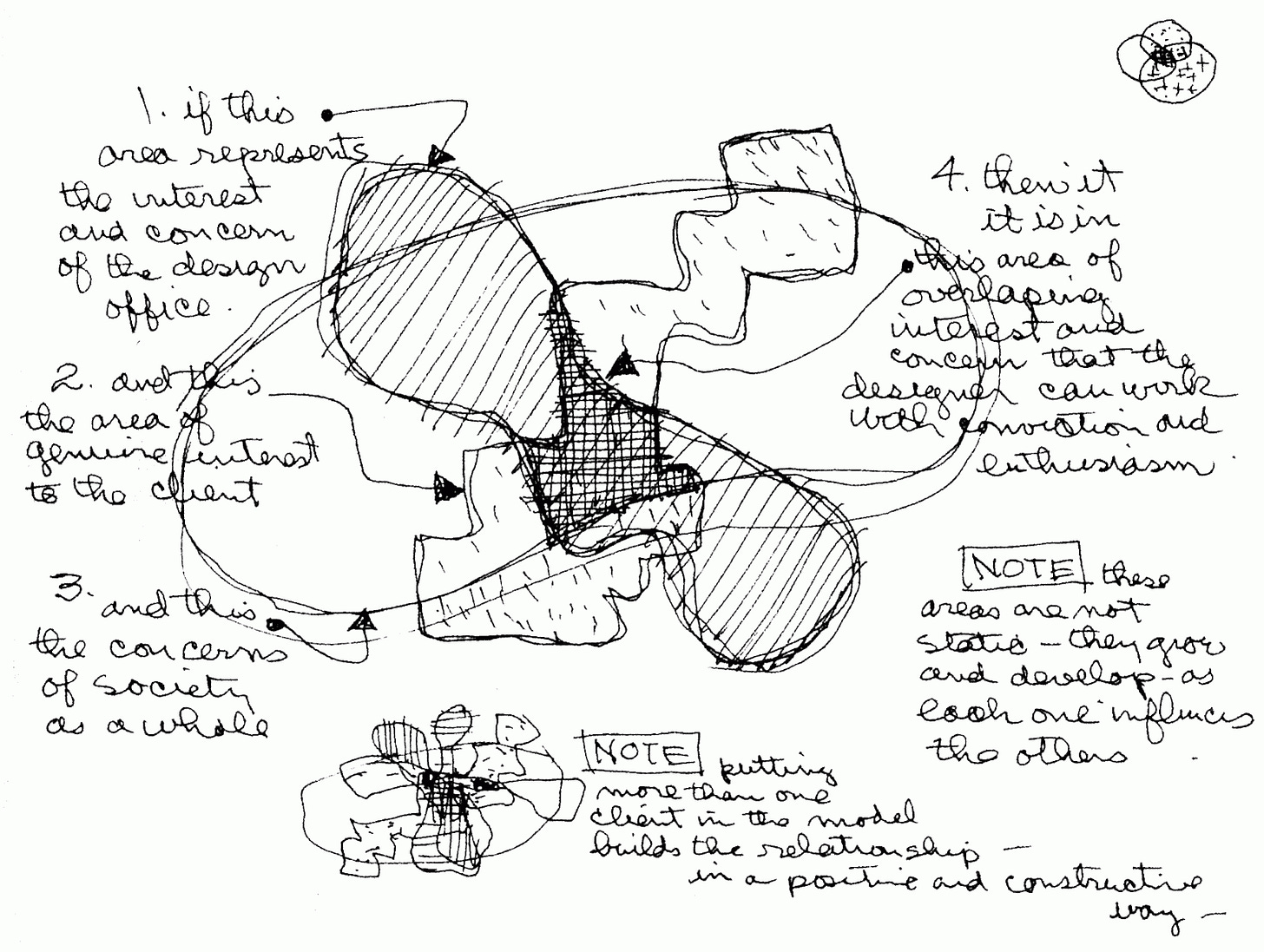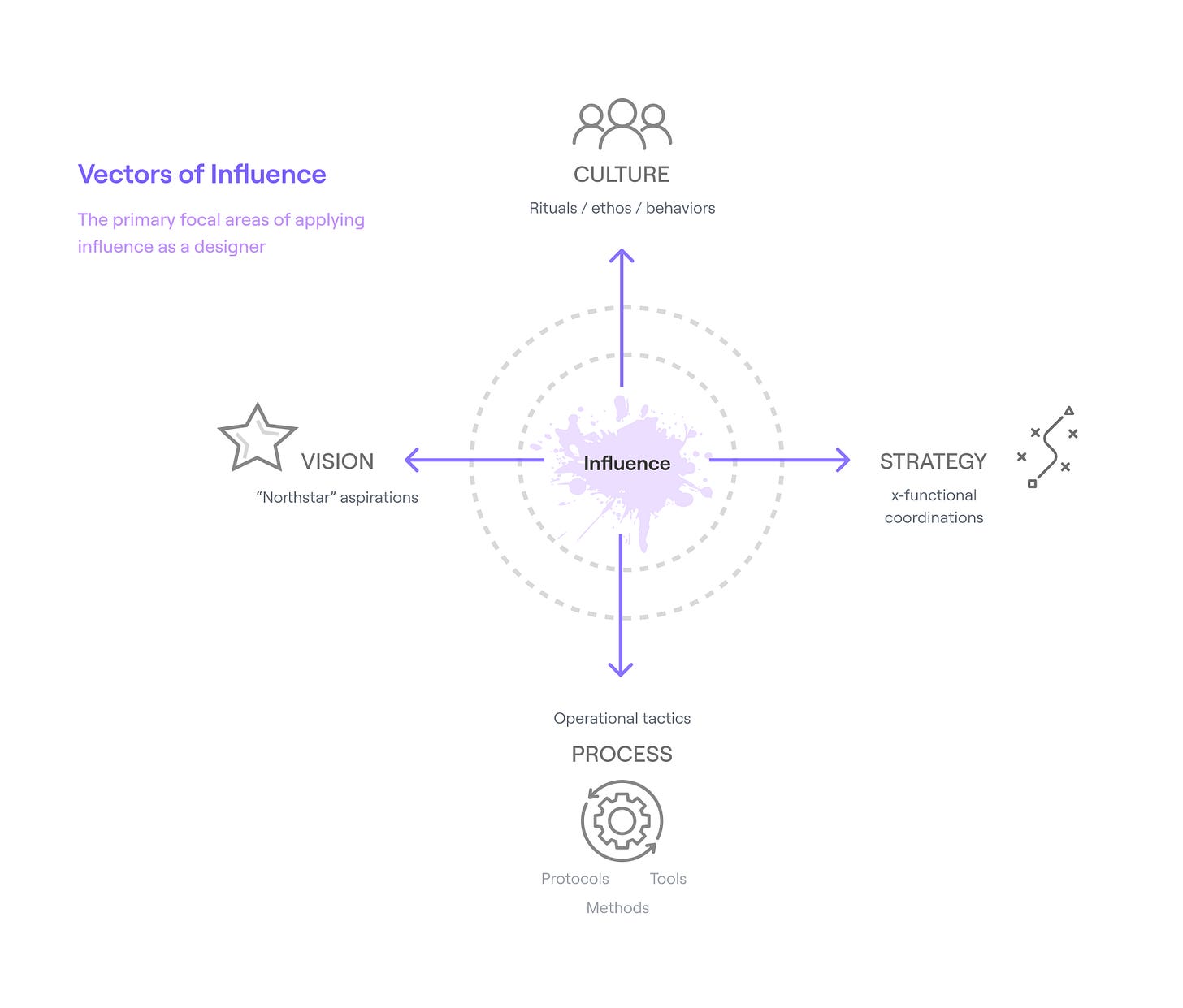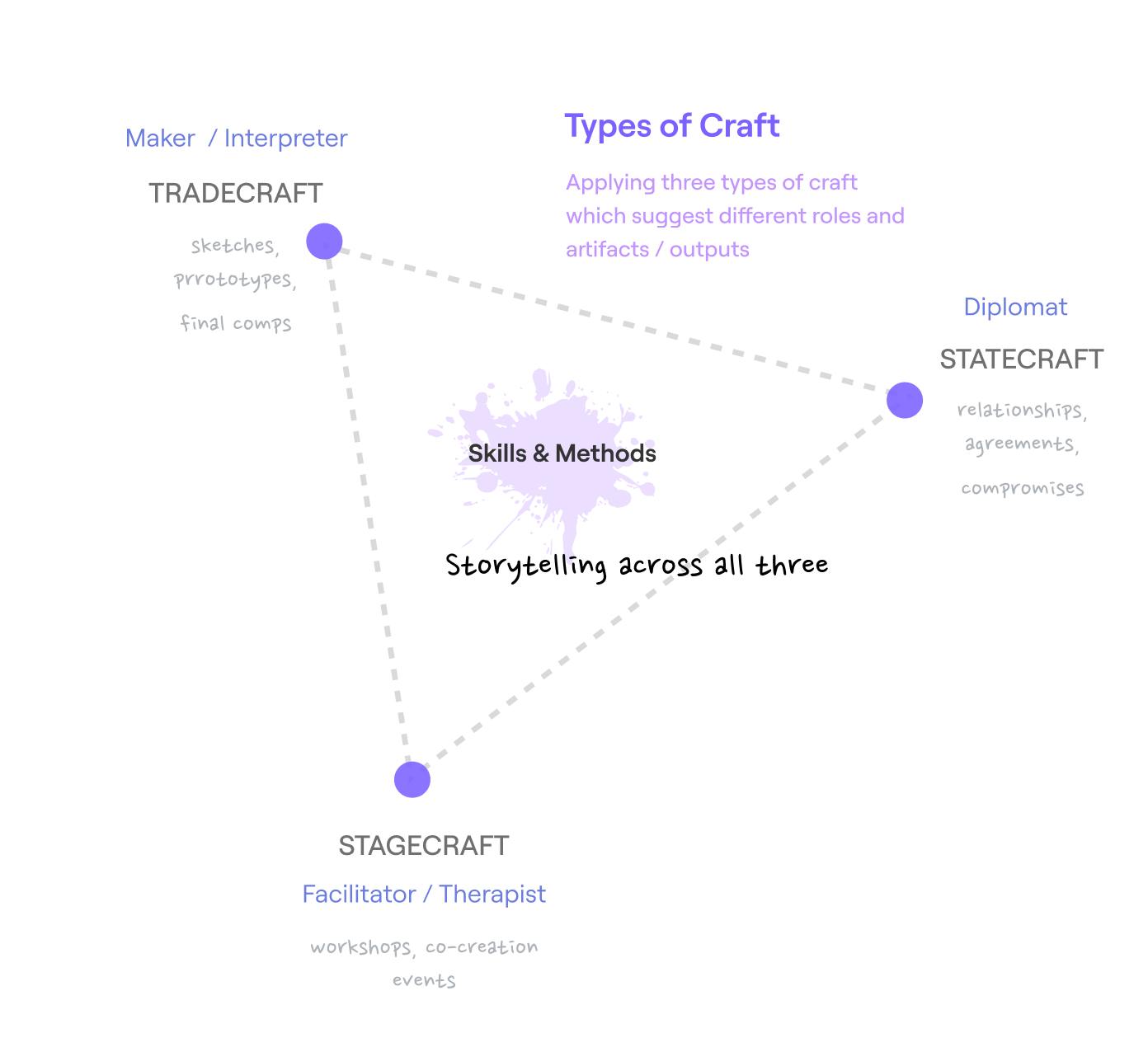Design is at the intersections
It's not an isolated activity in a tool, but thrives on dynamic tensions
More than ever it’s important to remind ourselves — design happens at the intersections. It is not an isolated activity in a design tool or a task ticket.
Design happens when diverse people of contrasting views and/or competing goals work together to solve a problem, per human-centric principles.
So as designers we work dutifully, to strive to deliver a solution that supports a particular audience — users, customers, a market, so forth. Sales targets, engineering constraints, marketing goals, and now increasingly demanding societal and environmental challenges -- these are the essential concerns common to most problems. A designer’s central task is to find a common ground that connects the differences, to amplify the meaningful in service of a humanist aim. It involves a messy, dynamic process of iteration & negotiation, as embodied by Charles Eames's hand-drawn diagram referenced below. This sketch conveys the critical concerns beset upon a designer for any medium or industry, who is seeking resolution and success.
During my 20+ years working in the tech industry as an interaction designer, I often went back to reflect upon this simple yet profound diagram — it somehow just seized my attention, and aspiration, years ago. I mean, just imagine being in that cross-hatched center, trying to guide people to the “right place” — ostensibly a good design — while volatile tensions bubble and clash, dynamically all around. 😅 It is in many ways an authentic abstraction of reality, particularly in the tech industry! Eames’s model shows how a designer is caught in the middle, a swirling center of contested agendas and priorities; it is not a fun spot at all! Yet, that is precisely where the designer must work, tackling layers of challenges to find the connections across various issues and to develop a strategic direction that guides everyone through the pursuit of improving a user’s pain or innovating a new possibility.
Every design (problem framing & solving) context is fraught with contrasting perspectives that give shape to the potential for productive change – if you know how to see it!
In practice, such contexts are largely situations of cross-functional deliberation, guided by selfish aims via politics. A mentor once described politics as “the subtle maneuvering of ideas for personal gain”; thusly described, every situation is basically a political one with the maneuvering of aims per someone’s incentives. Maybe a stakeholder is aiming for that promotion or securing a hefty commission on a big sale, or simply looking to be “in charge” to soothe a tender, fragile ego — there’s often something at play! So the challenge for designers (and design leaders, especially) is to navigate politically nuanced spaces via certain “vectors of influence” while striving to solve a complex problem — via artifact, discipline, mindset, or even just a good healthy debate! 😇
Today, designers are often asked to deliver “quick fixes” or crank out an “MVP” again and again…and again. 😒 Designers are constantly pressed to ship tactical point solutions, and to iterate feverishly to meet ever-changing, velocity-based metrics. However, we cannot, and must not, lose sight of a designer’s ability to operate at greater altitudes of forethought. We must fight1 to consider the human impact of what we create, and why we do so – it’s about the emotive, humanist narrative that expresses some kernel of optimism, and even compassion — perhaps needed more than ever before against a constant canvas of crises. 😬 Pointing forward from Eames’s diagram, this will require educating & inspiring emerging generations of design leaders to know how to contend with dynamic influence vectors for maximum benefit — beyond the tactical outputs of software tools.
For instance, how might a designer shepherd an inspiring vision that provokes stakeholders to clarify (and prioritize) the kind of world they want to live in, and manifest for their customers & communities for their mutual benefit? Upon defining that vision, there’s the pragmatic question of strategy. How might the designer help teams connect hidden yet critical dots with intent & clarity—thus shaping deliberate paths, phases, and horizons of progress, with iteration and feedback loops. This requires knowing how to facilitate complex, stressful dialogues with skeptics. 🤨 Then, getting down to daily cross-functional routines, it is vital to define a good, healthy process; this requires demonstrating best practices for everyone, and inviting all to participate, especially those farthest from the (virtual) “design space” who might feel disconnected or somehow separate. Finally, culture is the most challenging arena of influence, as this requires deep empathy for stakeholders, sussing out their issues and knowing how to support them so they feel respected, valued, backed by a common ethos of unifying, living values. 🤲🏽
When taken together, these vectors project an outlook on “design” itself as a necessary value and essential priority for an organization. Borne out of dynamics tensions at the edges, design finds itself taking root at the center.
Thus, we must foment and support the conditions for design to thrive by shaping “design” itself, or what I call metadesign. This involves:
Reflection in action: Consideration of inferred relationships and potential consequences in the midst of designing.
Strategic forethought: Looking ahead to connections among an organization’s disparate functions, decisions, attitudes, and outcomes.
Intellectual humanism: Lending a nuanced vocabulary informed by critical lenses and depth of analysis around problems.
Creative provocation: Suggesting that which is radical and speculative to spark risky dialogues and enable fresh perspectives.
By pursuing these approaches, and by operating at ever more senior levels of influence, the emerging design leader can effectively address strategic & cultural matters that determine whether good design will truly happen, or not. 🤷🏽 This also requires an adept mixing of different types of “craft”, an agility in applying the right type at the right moment, along with these influence moments of shaping a healthy designerly ethos — tradecraft (creating meaningful artifacts that reveal possibilities), stagecraft (setting up constructive workshops/collaborative moments), and statecraft (building healthy relationships via conversations).
Finally, this all depends on two other key elements — One is sensemaking of complex, wicked situations, via rapidly iterative artifacts that are disposable yet help build a collaborative narrative about the problems or opportunities; it’s a pastiche that may be rough-hewn, but usefully provocative. Think of those maps, models, journey, conceptual sketches and diagrams that serve to orient, align, and anchor teams on a language and structure of the system, jobs, and such. The other element is the ability to map out pathways through an experience model, via communications, interactions and transactions — or rather, the economics (behavioral, attentional, etc.) so as to facilitate the aspirations of a customer or stakeholder. This speaks to entire customer experience service models, the pathways of discovering and realizing value at multiple touchpoints — are they well-choreographed and connected?
So, to bring it all back — design happens at the intersections, not in isolation in some tool or task ticket. The dynamic tensions of contrasting views, debate/argument, and meaningful conversations are essential.
By mastering these capabilities of craft, influence, and pursuing the values of “metadesign”, this can amplify the efficacy of design amidst ambiguous, turbulent times where the problem is often not the problem, but symptomatic of a greater, perhaps more wicked concern at the level of social, strategic, and cultural impact. This then begs designers & leaders to ask: Why does this problem exist at all, and is it worth solving? And if we don’t, are we OK living with the cost? It is a somewhat dangerous question, potentially challenging deeply held beliefs and some sacred truths taken for granted by the organization. But if borne out of genuine curiosity and humanistic intent, asking such a question might be exactly the right thing to do. That’s leading by design. 🔥
As legendary modernist designer Massimo Vignelli famously said, “The life of a designer is a life of fight — fight against the ugliness.”





